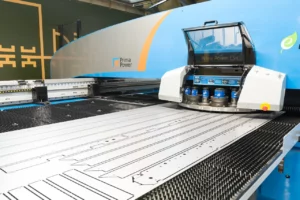Across much of Eastern Europe, a security door isn’t a luxury – it’s a standard feature of every home. From Warsaw to Belgrade, reinforced and certified doors are as common as double glazing.
In the UK, however, the story has been very different. For decades, homeowners relied on traditional timber or aluminium doors, with security treated as an optional extra rather than a core requirement.
This shift offers major opportunities for retailers, architects, and distributors.
Why Security Doors Became Standard in Eastern Europe
The widespread use of security doors in Eastern Europe can be traced back to the 1990s and 2000s, when burglary rates were high and property owners sought more reliable protection. In many countries, certification quickly became a trusted benchmark for quality and safety.
As adoption spread, homeowners began to expect these doors as part of every renovation or new build.
As noted by European testing institutes such as ift Rosenheim, decades of development around the EN 1627 burglar-resistance standard have normalised the installation of tested and certified doors in residential projects. Resistance Class 3 (RC3) doors, in particular, are now commonplace across the continent – demonstrating how protection and everyday design have become intertwined.
Why the UK Market Lagged Behind
The UK, by contrast, developed a different mindset. Timber stayed the preferred “premium” material, while design often outweighed performance. Most homeowners – and even many developers – were unaware of testing standards such as LPS 1175 or Secured by Design.
Security was often seen as an unattractive, industrial product – something more suited to a warehouse than a townhouse. As a result, “security doors” never entered mainstream building specifications. Instead, the market continued to focus on style, with only a handful of specialist providers catering to high-security needs.
Why the Market Is Waking Up Now
In recent years, several forces have started to change attitudes in the UK.
Rising concerns about burglary in urban areas, particularly London, have made security a greater priority for homeowners. At the same time, the luxury property market has expanded, with architects and developers seeking solutions that combine aesthetic freedom with certified performance.
International buyers have also played a role. Many come from regions where security doors are a given, and they are often surprised to find they are not part of the standard specification in the UK. Their expectations are now shaping demand — and retailers who fail to adapt risk being left behind.
Professional bodies are also responding. RIBA’s Security Overlay, developed with the National Protective Security Authority (NPSA), now encourages architects to integrate physical security from the earliest stages of design. This guidance marks a turning point – showing that performance and appearance can, and should, coexist within architectural planning.
What This Means for UK Retailers and Distributors
For trade partners, the message is clear: the UK market is changing, and certified security doors are moving from niche to mainstream. Retailers who expand their portfolios now can:
- Lead the way in a category that competitors may not yet address.
- Meet the expectations of architects and international clients.
- Position themselves as forward-thinking suppliers, aligned with European security standards and design guidance.
The Security Doors Factory Advantage
At Security Doors Factory, we bring together the best of both worlds: European-level security performance and British design sensibility.
Our doors are manufactured in the UK to LPS 1175 SR3 standards, ensuring trade partners can offer products that meet the highest levels of protection – without compromising on architectural style.
By partnering exclusively with professional resellers, developers, and design specialists, we’re helping shape a market where certified protection becomes as integral to the home as insulation or glazing – a true step toward aligning the UK with Europe’s mature approach to secure design.


Frequently Asked Questions
Security doors became common in Eastern Europe during the 1990s and 2000s, when high burglary rates drove demand for stronger home protection. Manufacturers began producing certified, reinforced doors tested to EN 1627 standards, and soon these became a standard feature in residential construction – much like double glazing today.
The UK market traditionally prioritised design aesthetics over physical protection, with timber and aluminium viewed as premium materials. Many homeowners and even developers were unfamiliar with standards such as LPS 1175 or Secured by Design, which meant that certified doors remained niche rather than mainstream.
Europe typically uses the EN 1627 burglar-resistance classification (RC1–RC6), while the UK relies on LPS 1175 security ratings (SR1–SR8) and Secured by Design approval. Both assess resistance to forced entry, but LPS 1175 is often viewed as more demanding, especially at higher grades.
Security Doors Factory (SDF) combines European-level engineering with UK manufacturing and compliance. All doors are tested to LPS 1175 SR3 and built to meet the design expectations of British architects. By supplying exclusively to trade partners, resellers, and developers, SDF helps align UK projects with European standards of security and design quality.
Demand for certified, design-led security doors is growing fast. International buyers expect the same protection they have in Europe, and UK architects increasingly specify certified doors for luxury and high-value properties. Retailers who act early can establish themselves as trusted suppliers within this expanding category.
